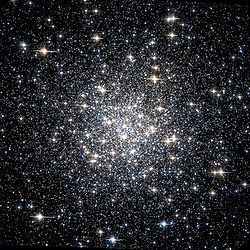Messier Index/M56
Appearance
| Messier 56 | |
|---|---|
 | |
| Observation data (w:J2000 epoch) | |
| Class | X |
| Constellation | Lyra |
| Right ascension | 19h 16m 35.50s[1] |
| Declination | +30° 11′ 04.2″[1] |
| Distance | 32.9 kly[2] (10.1 kpc) |
| Apparent magnitude (V) | +8.3 |
| Apparent dimensions (V) | 8′.8 |
| Physical characteristics | |
| Mass | kg ( M) |
| Radius | 42 ly[3] |
| Other designations | M56, NGC 6779, GCl 110[1] |
Messier 56 (also known as M56 or NGC 6779) is a w:globular cluster in the w:constellation w:Lyra. It was discovered by w:Charles Messier in w:1779. M56 is at a distance of about 32,900 w:light-years from w:Earth and measures roughly 84 light-years across.
The brightest w:stars in M56 are of 13th magnitude while it contains only about a dozen known w:variable stars like V6 (RV Tauri star; period: 90 days) or V1 (Cepheid: 1.510 days); other variable stars are V2 (irregular) and V3 (semiregular).
External links
References
- ↑ a b c "SIMBAD Astronomical Database". Results for NGC 6779. Retrieved 2006-11-16.
- ↑ w:Valentin D. Ivanov et al., Near Infrared Photometry of Galactic Globular Clusters M56 and M15. Extending the Red Giant Branch vs. Metallicity Calibration Towards Metal Poor Systems
- ↑ distance × sin( diameter_angle / 2 ) = 42 ly. radius

